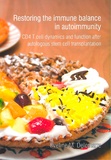Restoring the immune balance in autoimmunity
CD4 T cell dynamics and function after autologous stem cell transplantation
Summary
Despite the implementation of biologicals for autoimmune disease (AID) treatments, some patients remain therapy refractory. For these patients, autologous hematopoietic stem cell transplantation (aHSCT) can be considered as an alternative therapeutic option. aHSCT is the only treatment that is able to induce disease remission. The general idea behind aHSCT to treat AID is that immune reconstitution in a less pro-inflammatory environment after profound depletion of the uncontrolled system leads to restoration of the immune balance and regain of immune tolerance. However, the underlying working mechanisms remain largely unknown. In addition, aHSCT is associated with major side effects and disease remission may not be ever lasting. However, patients that experience a disease relapse do respond again to previous ineffective therapies, suggesting that aHSCT remodulates the immune system. Our goal was to investigate the immunological mechanisms that occur during aHSCT. More fundamental insights will facilitate the development of new therapies without toxic side effects. Since it is impossible in patients to discriminate between T cells that derived from the infused graft or that survived conditioning (host T cells), we explored the reconstitution of the CD4+ T cell compartment after aHSCT in a proteoglycan induced arthritis (PGIA) mouse model. Therefore, we used congenic bone marrow transplantation (BMT) between mouse strains with a distinct congenic marker that allows discrimination between T cells that are graft or host-derived. This model showed that BMT induced a graft-derived CD4+ T cell compartment that developed in the thymus. Moreover, graft-derived effector CD4+ T cells were more tolerant compared to host effector T cells and graft-derived Treg were better suppressors than host Treg. In patient samples, we explored Treg renewal via T cell receptor (TCR) variable β chain (TCRVβ) spectratyping, demonstrating that before aHSCT the Treg TCR repertoire was oligoclonal. Importantly, successful aHSCT correlated with a renewed and diverse Treg repertoire, suggesting that Treg renewal is important for disease remission. As an initial therapeutic approach, additional Treg were infused with the graft in the PGIA model. However, this did not result in clinical improvement and even caused a donor T cell reconstitution delay. Therefore, we conclude that Treg therapy in an aHSCT setting should be approached with caution. Furthermore, the expression patterns of three disease-associated cytokines were investigated after aHSCT in refractory juvenile dermatomyositis patients. Gradual reduction of cytokine levels were observed after successful aHSCT, suggesting that these cytokines are most likely not produced by conditioning depleted immune cells, but by tissue cells. At last, the thymus is important for T cell reconstitution after aHSCT. Samples from young thymectomized patients served as a model to investigate T cell reconstitution when a thymus is absent. This demonstrated that thymus depletion leads to an altered naïve T cell phenotype. In conclusion, the data described in this thesis indicate that clinical improvement of AID after aHSCT involves renewal of the CD4+ T cell compartment that is graft- and thymus-derived. Currently there is renewed interest in reducing conditioning regimes and the necessity of stem cell infusions. We propose that graft infusions are important for disease remission, while milder conditioning regimes may lead to less efficient engraftment. Future research should therefore focus on the importance of conditioning regimes in relation to engraftment efficiencies. This knowledge will help to develop new therapies without toxic side effects.
